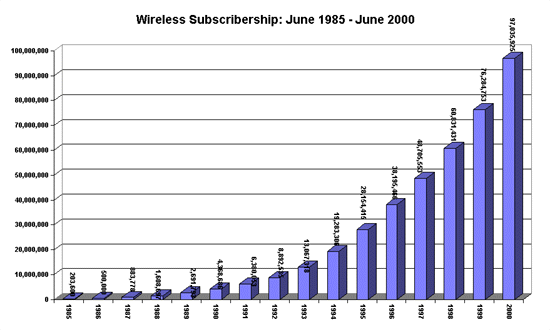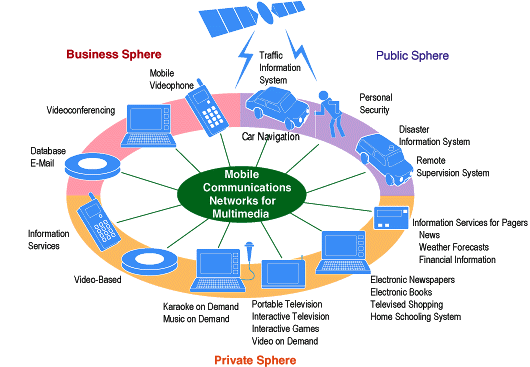
Consumer Demand: The Missing Link in 3G Business Strategies
To anyone over 50, the growing presence of mobile phones is little short of miraculous. Once the costly tools of fire, police, and professional delivery services, mobile communication devices rapidly became the status symbols of wealthy professionals and now are commonplace artifacts. In fact, they’ve become so omnipresent that I begin every class by asking my students to silence their cellular phones. Should I forget, there is a better than even chance that I will be reminded by an annoying beep or tune within the first five minutes of any lecture.
If you doubt the growing presence of mobile communication devices, glance at the following graph from the Cellular Telephone Industry Association (www.ctia.org).

The growth is impressive and there is good reason to believe that wireless service is often used as a substitute for conventional wire-line service. While growth and market penetration are encouraging, mobile communication service providers have two concerns:
· The rate of growth in developed countries is beginning to slow and we may be approaching market saturation.
· Competition has created pricing pressure and subscribers’ average monthly bills are actually declining in spite of increased usage.
Telecommunication companies facing the prospect of declining revenues have adopted two strategies. First, they are moving aggressively to deploy networks in developing countries. This strategy is attractive because there are significant growth opportunities in overseas markets. Sadly, there are also significant drawbacks; viz., the activity is capital intensive, local political and economic turmoil may adversely affect deployment, and a growing number of global competitors have adopted the same strategy.
The second strategy is likely to have a greater impact on readers of this note. Both established and emerging service providers are encouraging customers to employ more capable—hence, more expensive—services. We have already witnessed the initial effects of this strategy, and customers accustomed to voice or paging now have the option of receiving text messages or surfing selected portions of the Internet with their handheld devices. Increasing usage and average revenue per customer is attractive to both telecommunications service providers and equipment manufacturers, and “3G” or “third generation wireless” are the current code words for the new services expected to drive demand.
For readers who have chosen to
focus elsewhere, 3G services will employ digital, packet-switched networks to
provide wireless voice, data, and entertainment services to handheld devices. In
other words, your mobile phone will become a telephone, Internet terminal, and
entertainment center all rolled into one device. Here’s how one manufacturer
portrays the range of services provided.

While the image is attractive, the extent and pace at which consumers will flock to expanded wireless services are open questions. This is the context in which I read two recent news reports.
The first came to me from www.internetwk.com
and is entitled “Study: Customers Willing to Pay for Rich 3G Apps.”[1]
Based on an IDC study commissioned by Qualcomm, Microsoft, and Lucent,
the article reports that at least “some consumers are willing to pay for the
type of mobile applications that 3G can deliver.” Based on the reactions of
approximately 1,000 business users, consumers, and early adopters, IDC concluded
that mobile professionals with children show the greatest willingness to pay for
3G services. The results indicated that accessing e-mail with large attachments
was the most attractive application followed closely by accessing pictures and
music. In addition, IDC estimates that some 700,000 users will sign up for 3G
services by the end of 2002.
Shortly after perusing the first article, I stumbled upon the second: “Wireless field of dreams? Don’t buy the hype.”[2] Likening the methods employed by many consulting firms to tossing chicken bones, the author notes that accepting predictions in commonly quoted reports leads to an optimistic bias. The author proposed use of a “523 Rule” as an appropriate antidote. Here’s how it works:
Unless a research firm has accurately tracked a market for five years, take its current analysis and double the length of time predicted, then cut the market size to one third.
While IDC is among the more conservative market research firms, applying the 523 rule would produce the following result for 3G wireless services: by September 2004, there will be slightly over a quarter million 3G subscribers.
That may be an overly cautious
estimate because there is always the prospect of “wildfire” takeoff, but it
is consistent with current economic conditions. In addition, telephone companies
may need to provide a variety of free services to entice customers into trying
the new offerings.
Eric Wm. Skopec, Ph.D., is the Regional Director for Business and Management at Learning Tree University, and author of several books including The Global Telecommunications Revolution (Irwin/McGraw-Hill, forthcoming). His email address is at ERIC@LTU.ORG
Learning Tree University has campuses in Chatsworth, Thousand Oaks, and Irvine, California, with a growing number of courses in Business, Information Technology, and Professional Digital Arts available over the Internet. For further information, please visit http://www.ltu.org
[1] Jade Boyd, Today’s News, March 20,2001 at http://www.internetwk.com/story/INW20010320S0007.
[2] March 26, 2000 at www.individual.com/
Send mail to editor@biznetonline.com with questions or comments about this web
site.
Copyright © 1997 ~BizNet OnLine Magazine
Last modified: November 08, 2002